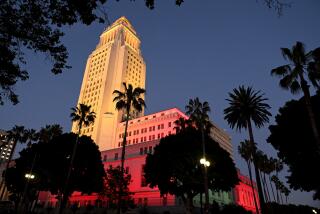Consider the Big Picture in Creating L.A.’s Open Spaces
Important developments are occurring in the world of L.A. parks. Land is being set aside for recreation and open space along the Los Angeles River, atop the Baldwin Hills in Highland Park and at the Cornfield site. Neighborhood associations and other organizations long active in political contests for more parks and playgrounds have garnered the authority needed to convert plans into parkland. Significant public and philanthropic funds are available to finance these efforts. Both Los Angeles mayoral candidates endorse plans to improve existing parks and to develop additional sites.
But will City Atty. James K. Hahn or Antonio Villaraigosa take the discussion of Los Angeles parks into more ambitious territory? Will either’s election be marked by bold moves toward comprehensive, as opposed to incremental, park planning? ‘More parks” is an uncontroversial, unimaginative plank for a municipal election. Might one of these two politicians enlarge the debate from the scale of discrete parks to big ideas about the L.A. environment?
History offers a perspective on the question. Seventy-one years ago, a group of Angelenos and urban planners unveiled an ambitious open-space plan for L.A. County. “Parks, Playgrounds and Beaches for the Los Angeles Region” was the product of a three-year effort sponsored by the Los Angeles Chamber of Commerce. The authors of the report were the best-known landscape architecture firm in the nation, Olmsted Brothers of Brookline, Mass., and the planning firm Harland Bartholomew and Associates of St. Louis.
Describing a “crisis in the welfare of Los Angeles,” Olmsted and Bartholomew urged immediate action. The county had far fewer acres devoted to playgrounds and parks than other metropolitan areas. The ratio of public space to residents fell far below national standards. Bridging this shortfall would become increasingly difficult as people moved into the region and more land was developed for residences, businesses and industry. Ensuring existing recreational amenities against encroachment and setting aside additional sites for outdoor play and leisure were the only solution.
In nearly 200 pages of text, diagrams and photographs, the Olmsted-Bartholomew plan depicted a coordinated system of neighborhood playgrounds and parks connected by pleasure drives or parkways. If implemented, the plan would have linked open space across Los Angeles reaching out to far-flung regional “reservations” in the surrounding mountains and deserts. It was, in short, a masterful environmental vision for the metropolis, Boston’s Emerald Necklace transplanted to and adapted for the climate, ecologies and lifestyles of the Pacific Coast. As landscape architect Laurie Olin has suggested, the planners laid down a challenge. Could L.A.’s civic-commercial elite think big?
Apparently not. “Parks, Playgrounds and Beaches” disappeared into a black hole. Because the planners it hired proposed such sweeping environmental recommendations and, more to the point, equally sweeping reconfigurations of local governance to make it all happen, the Chamber of Commerce responded by killing off the report it had commissioned and financed. The chamber’s leadership would not brook the creation of a super-jurisdictional parks board (exactly what Olmsted and Bartholomew wanted), lest the new body threaten its regional clout. A print run of fewer than 200 copies ensured that the report would be more keepsake than blueprint. A bold plan--a brilliant plan--died at the hands of petty political defensiveness and environmental myopia.
Ironically, Olmsted had predicted as much. Years earlier, he had written a Los Angeles resident that the implementation of any comprehensive regional plan for Southern California would owe as much to what he called “the art political” as it would to any technical prowess. True to his prediction, in 1930, partisan politics and a limited view of community and the civic good meant that a bold yet pragmatic vision for a very different environmental future was cast aside.
Yet, this greener vision retains its power, not least because of continuities in the environmental challenges facing the county. Coastal development, beach access, wetland preservation, ecologically sensitive habitats, limits to growth, attempts at some manner of sustainability--these issues remain on the front page and at the forefront of regional concerns.
Over the last several months, each of the mayoral candidates spoke passionately and optimistically whenever the debate turned to issues of environmental planning. Most invoked the Olmsted-Bartholomew plan as an opportunity missed. Dusting off this report is a step in the right direction, and we would be the first to argue that there is much to learn from history. But an appreciation of what might have been must be coupled with ambitions for the future and what might be. Big plans and big ideas, especially about cities and the environment, are out of favor. This should not be the case. Incremental advances will mean all the more if linked to a comprehensive regional plan for recreation and open space. Certainly, Los Angeles of the 21st century deserves as grand an environmental vision as the one that Olmsted and Bartholomew gamely put forth a lifetime ago.
More to Read
Sign up for Essential California
The most important California stories and recommendations in your inbox every morning.
You may occasionally receive promotional content from the Los Angeles Times.









